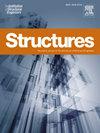用柔性纤维增强聚合物条或网格增强的3D打印混凝土:概念和粘结测试
IF 4.3
2区 工程技术
Q1 ENGINEERING, CIVIL
引用次数: 0
摘要
3D打印混凝土广泛应用的主要挑战之一是缺乏可靠和方便的加固程序来提高打印结构的耐久性和结构性能。本文提出了两种创新的纤维增强聚合物(FRP)网格或带状增强方法,即同步打印法和层间铺设法。通过利用FRP网格/带状的灵活性,提出的加固方法旨在实现混凝土和钢筋的同步打印。作为第一步,进行了一个实验程序来评估FRP与3d打印混凝土之间的粘结性能。为此,制作3d打印混凝土试件,并嵌入FRP条或网格,进行拉拔试验。详细考察了各关键参数对粘结性能的影响。试验结果表明,采用同步打印方式制作的FRP与3d打印混凝土的粘结强度可达14.0 MPa以上,采用层间铺设方式制作的FRP与3d打印混凝土的粘结强度可达4.0 MPa以上,显示了所提出的加固方法在实践中的巨大潜力。本文章由计算机程序翻译,如有差异,请以英文原文为准。
3D printed concrete reinforced with flexible fiber reinforced polymer strips or grids: Concept and bond tests
One of the major challenges for the wide application of three-dimensional (3D) printed concrete lies in the lack of a reliable and convenient reinforcement procedure for improving the durability and structural performance of the printed structures. This paper presents two innovative reinforcing methods using fiber reinforced polymer (FRP) grids or strips, i.e., the synchronous printing method and the inter-layer laying method. By capitalizing the flexibility of FRP grids/strips, the proposed reinforcing methods aim to achieve the printing of concrete and reinforcement synchronously. As the first step, an experimental program was conducted to evaluate the bond performance between FRP and 3D-printed concrete. To this end, 3D-printed concrete specimens with FRP strips or grids embedded were fabricated and pull-out tests were conducted. The effects of various key parameters on the bond performance were examined in detail. The test results showed that the bond strength between FRP and 3D-printed concrete could reach above 14.0 MPa for specimens fabricated with the synchronous printing method and above 4.0 MPa for those with the inter-layer laying method, demonstrating the great potential of the proposed reinforcing methods in practice.
求助全文
通过发布文献求助,成功后即可免费获取论文全文。
去求助
来源期刊

Structures
Engineering-Architecture
CiteScore
5.70
自引率
17.10%
发文量
1187
期刊介绍:
Structures aims to publish internationally-leading research across the full breadth of structural engineering. Papers for Structures are particularly welcome in which high-quality research will benefit from wide readership of academics and practitioners such that not only high citation rates but also tangible industrial-related pathways to impact are achieved.
 求助内容:
求助内容: 应助结果提醒方式:
应助结果提醒方式:


